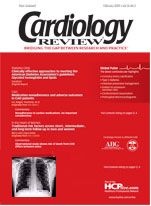Case report: Acute MI complicated by in-hospital stroke
An 88-year-old woman with a history of hypertension but no history of cardiovascular disease suddenly felt weak and lightheaded and was noted by her family to appear pale and fatigued. After a syncopal episode an hour later, she was transported by ambulance to a community emergency department. An inferior wall acute myocardial infarction (MI) was diagnosed based on the results of an electrocardiogram (ECG) and increased creatine kinase and troponin I levels. The ECG also showed complete heart block with a junctional escape rhythm. Findings from the physical examination showed pallor, diaphoresis, a heart rate of 40 beats per minute, a blood pressure of 140/80 mm Hg, jugular venous pressure of 9 cm, diminished breath sounds bilaterally, a soft systolic murmur localized to the apex, and diminished peripheral pulses in the lower extremities.
Soon after arrival at the emergency department, the patient was treated with intravenous tenecteplase (TNKase). However, despite therapy, she had persistent ST-segment elevations and complete heart block. She was then transferred to our institution for emergent cardiac catheterization. Angiography demonstrated a totally occluded proximal right coronary artery. The patient subsequently underwent rescue percutaneous coronary intervention with deployment of three stents. Although the residual stenosis was reduced to 0%, initially there was “no reflow” of coronary blood flow in the right coronary artery. Thrombolysis in Myocardial Infarction grade 2-3 flow was restored after the use of intracoronary nitroglycerin and adenosine (Adenocard). Results of left ventriculography and echocardi-
ography confirmed a left ventricular ejection fraction of 30% to 35%; akinesis of the inferior, inferoseptal, and inferoapical walls; moderate mitral regurgitation; and left ventricular end-diastolic pressure of 28 mm Hg. The patient required immediate temporary transvenous pacing followed by permanent pacemaker implantation on hospital day 7.
On hospital day 6, the patient developed dysarthria and right upper extremity weakness. An imme-diate head computed tomography (CT) scan was normal, but a head
CT 48 hours later showed a new
left parietal lobe infarct without hemorrhage. Bilateral carotid artery duplex studies were abnormal but without critical stenoses. Two weeks after hospital admission, the patient was diagnosed with worsening respiratory failure secondary to congestive heart failure complicated by hypotension. One day later, the patient died.
This case shows the occurrence of a nonhemorrhagic stroke in an elderly patient following inferior MI. As shown in our study, elderly patients are at significantly increased risk for stroke regardless of MI location. Although stroke risk following fibrinolytic therapy increases with age, the majority of cerebrovascular events are nonhemorrhagic. As seen in this patient, who had a history of hypertension, mild cerebrovascular disease, and heart failure, the existence of multiple comorbidities in the elderly likely plays a significant role in this increased risk. In addition, patients who develop acute stroke are at markedly increased risk of dying during hospitalization, as was the case with our patient. Aggressive identification and treatment of modifiable risk factors for stroke following MI, particularly in the elderly, are indicated. n
